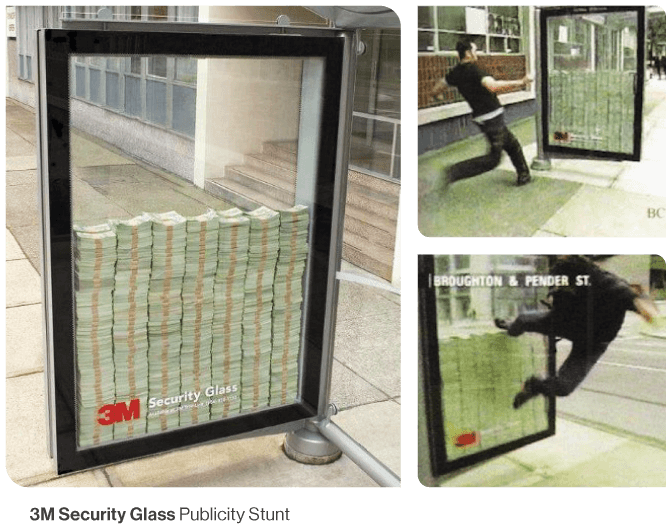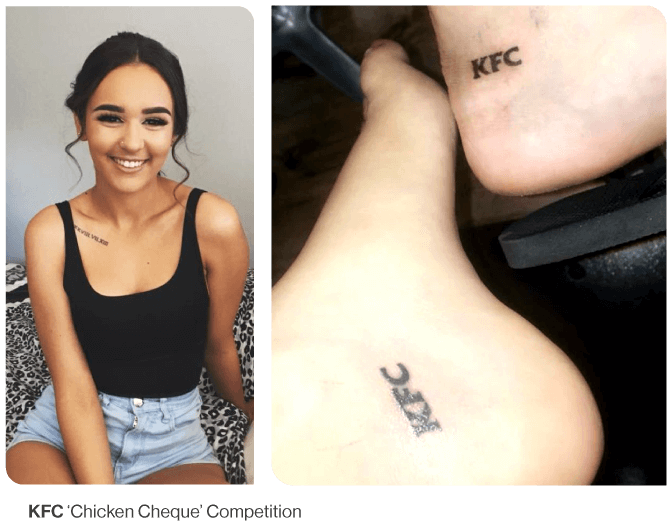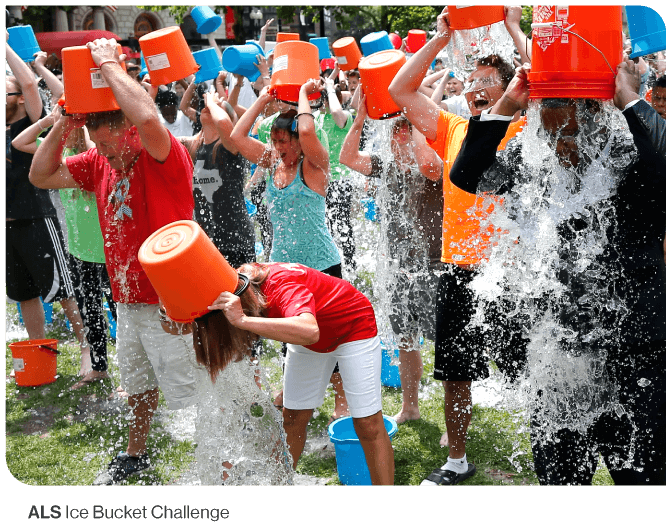‘Going viral’ is something all marketers strive for. A campaign or promotion so powerful, so relatable and so engaging that it takes on a life of its own, capturing eyeballs across the globe.
The opportunity to get your brand in front of as many people as possible is something most companies would pay a small fortune for – and quite a few have. But, the beauty of viral marketing is that it can propel any brand into the spotlight, costing next to nothing.
Now, if it was easy to go viral, every brand would have done it. Yet, with the right idea, the right timing and the right execution, marketing teams can capture lightning in a bottle and attract mainstream attention, even if they don’t have the resources of industry heavyweights.
Here we showcase 6 of our favourite low-cost viral campaigns, what we love about them and what lessons to take away to help your attempts to hit the headlines.
1. 3M’s unbreakable glass stunt

Stating that your product is unbreakable is a bold claim, and one that has backfired on brands in the past, such as when Tesla’s Cybertruck couldn’t withstand the test of a steel ball.
Nevertheless, 3M put their money where their mouth is with this publicity stunt – quite literally in fact. To promote their product Scotchshield, a see-through film designed to make glass stronger, they placed 3 million Canadian dollars in an advertising case at a bus stop in Vancouver for one day. If anyone broke the glass using their feet, they’d get the money.
Now we know what you’re thinking – $3 million doesn’t exactly sound like a low-budget campaign, does it? Well 3M hedged their bets a little when planning this stunt. It was actually only $500 in the case on top of a lot of fake notes.
Still, try as hard as the Canadian public might, the glass stood firm throughout. This not only reinforced the quality of 3M’s product, but is estimated to have earned them $1 million in free publicity and led to a three-month backlog for the Scotchshield coating.
Key lessons to take away:
- Give the audience for your campaign a simple task and an incentive, and they will generate the content for you
- Consider out-of-the-box ways to showcase your product’s USPs to the masses
- Be smart with your setup – 3M set the rule that the glass could only be kicked, and had security in place to ensure this was observed
2. Cheekd’s exhaustive guerrilla marketing

Guerrilla marketing is a strategy many brands have turned to when seeking to make an impact on a limited budget. By delving into the unconventional and surprising, marketers can leave a lasting impression on passers-by who may have never even heard of their brand before. But, you have to be relentless – a quality Cheekd CEO Lori Cheek had in abundance.
This dating app initially worked by encouraging users to hand out “business cards” to those they were interested in, containing a phrase, an online code and a URL to the user’s account. To push this unique approach and get her brand noticed, Cheek utilised a range of relatively low-cost guerrilla marketing techniques, including:
- Placing as many business cards as possible on shareable city bikes
- Slipping cards into random strangers bags, hoods, and pockets
- Attaching cards to the inside of subway cars, movie ads and the back of bathroom stalls
- Writing her URL on sidewalks in chalk
Now with a Bluetooth-based connection model, this exhaustive approach helped give Cheekd immediate notoriety, and it now boasts over 10,000 members.
Key lessons to take away:
- Guerrilla marketing doesn’t need to be elaborate, but it’s important to give it as much exposure as possible
- Simple things like plastering business cards or writing URLs in chalk can garner a lot of press
- Ensure your budget marketing still directly embodies your brand values and offerings
3. KFC’s tantalising tattoo offer

Contests and challenges can be a great way for brands to generate some inexpensive buzz. Consider how much Wendy’s gained years ago by simply responding to a tweet from someone asking for a lifetime supply of their nuggets.
Sticking with fast-food franchises, KFC took this approach by running a simple Facebook competition promising free food for a year for the person who could prove they were their biggest superfan. It was won by Sydney teenager Brooke Collins, who went to the lengths of getting a tattoo of their logo to prove her dedication.
By investing just $5,200 (£2,900) in the eventual prize – a tiny sum for a brand as huge as KFC – the company attracted a ton of traffic to their social channels, and then hit the headlines due to their superfan’s incredible response.
Key lessons to take away:
- Competitions and contests can inspire a significant number of reactions from your following
- Sometimes leaving instructions vague can encourage your audience’s creativity, which captures even more attention
- Present the prizes for your contests in as appealing a light as possible
4. Thursday’s fake cheating displays

Another dating app that made the most of a low-cost campaign was Thursday, which went viral by sacrificing their co-founder George Rawlings’ reputation.
Back when the app was known as Honeypot, they left a whiteboard on a London street supposedly from Rawlings’ girlfriend saying that she had caught him with another woman, and encouraged people to share this on social media as a form of revenge.
Of course many people did so, with every photo conveniently containing both Rawlings’ Instagram handle and the Honeypot brand name. This was followed up with similar future stunts, such as a man wearing a cardboard sign in the street saying this was his punishment for cheating on his girlfriend.
A stunt that cost little under £60 attracted over 1.5 million online impressions in quick order, getting the brand noticed in a big way.
Key lessons to take away:
- Shock value can go a long way when done effectively, but always proceed with caution
- Try to engage people’s empathy – here, everyone took the side of the “girlfriend”, inspiring them to share the messages online
- Don’t be afraid to make yourself silly for the sake of your brand
5. Range Rover’s vehicle vandalism

Speaking of spurned lovers, Range Rover took a comparable approach with this cost-effective viral stunt. To draw eyes to their new £90,000 luxury white model, they left one parked outside Harrods spray-painted with the words “cheater” and “hope she was worth it”.
Due to the location and the aura of Range Rovers, this attracted a lot of buzz from passers-by and beyond, including news headlines across the UK.
Although it soon came out that this was nothing more than a marketing prank, it had already done its job – thousands of people had been introduced to the new Range Rover, and potentially was the catalyst for several future sales.
Key lessons to take away:
- Location is important for effective guerrilla marketing – a luxury shop like Harrods was ideal for this Range Rover’s target audience
- Even brands with big marketing budgets can benefit from a low-cost approach
- It pays to put your products or services front-and-centre of your viral campaigns
6. The ALS Association’s Ice Bucket Challenge

The power of a viral campaign lies in its ability to reach audiences worldwide, and few have proven more effective in the past decade than the ALS Ice Bucket Challenge.
The concept was incredibly simple – pour a bucket of ice water on your head, and then challenge three others to do the same. Ironically, this ice-cold activity caught fire on the internet, with millions partaking in the challenge, including high-profile celebrities such as Dwayne Johnson, Lady Gaga, Oprah Winfrey and Tom Cruise.
This massively built awareness of ALS (Amyotrophic Lateral Sclerosis or Lou Gehrig’s disease), as well as raised in excess of $220 million globally for the ALS Association.
Key lessons to take away:
- User-generated content is a powerful, cost-effective way to spread your brand online
- Make the instructions for your activity simple and easy for people to do
- Ensure part of your instructions involve sharing the task with people’s friends, family, co-workers, celebrities, etc. – this keeps the viral chain alive
Finding success with low-cost campaigns
We hope you enjoyed these standout examples of brands that made a massive impression without boundless budgets. These demonstrate that, regardless of the initial investment, the right timing and the right concept can inspire a dramatic response in today’s digital age, reaching audiences worldwide.
Going viral certainly isn’t easy – especially with more brands battling for consumers’ attention than ever before. But we hope that these examples and the lessons alongside them encourage you to consider unconventional approaches and look for opportunities even when budgets are tight.
Of course, if you are looking to use your marketing budget to the fullest, or cut down costs so you can invest more into planning and executing unorthodox campaigns, BAM by Papirfly™ can be a powerful ally.
By making it faster and easier to create an infinite number of perfectly branded, studio-standard assets, regardless of design expertise, our solution significantly reduces production costs and timeframes. Your team can produce more for less, with no sacrifice in quality or consistency.
Start empowering your team with BAM today – reach out to our team, or get hands-on by booking your free demo.
